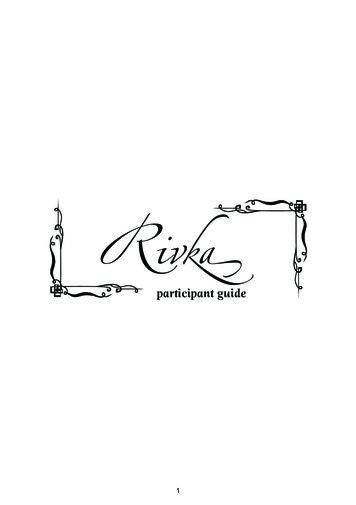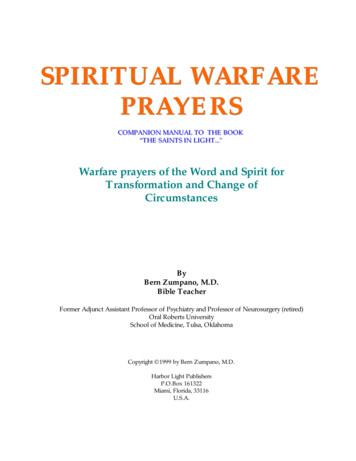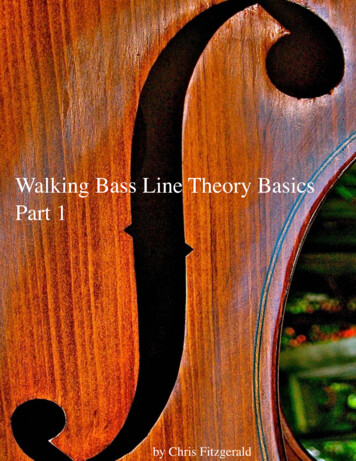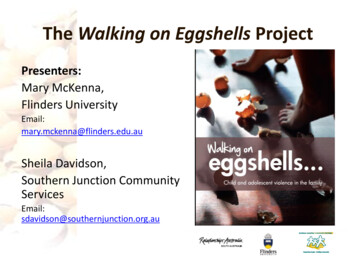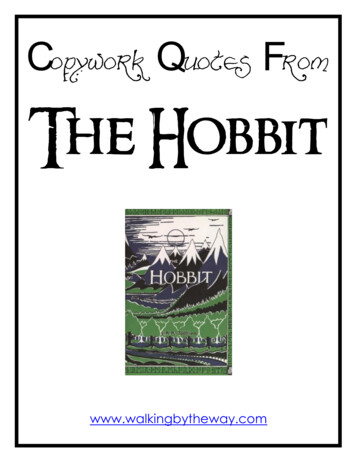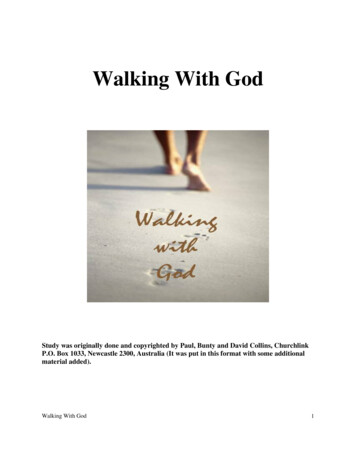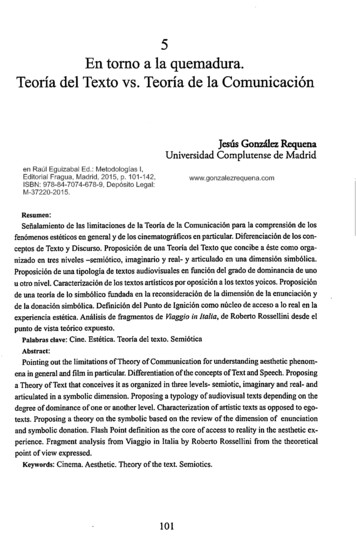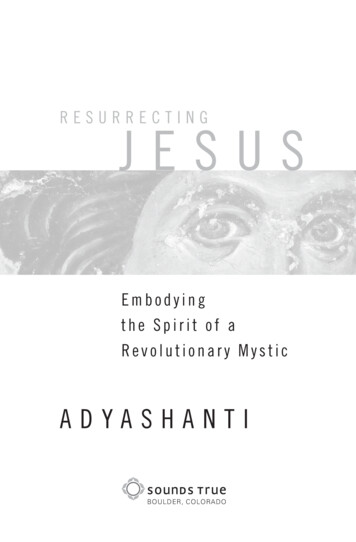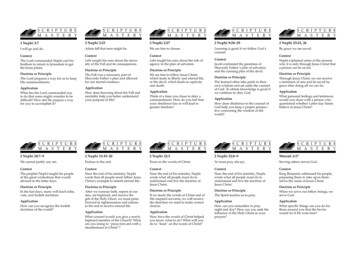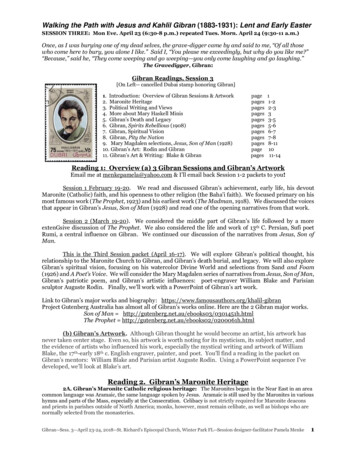
Transcription
Walking the Path with Jesus and Kahlil Gibran (1883-1931): Lent and Early EasterSESSION THREE: Mon Eve. April 23 (6:30-8 p.m.) repeated Tues. Morn. April 24 (9:30-11 a.m.)Once, as I was burying one of my dead selves, the grave-digger came by and said to me, “Of all thosewho come here to bury, you alone I like.” Said I, “You please me exceedingly, but why do you like me?”“Because,” said he, “They come weeping and go weeping—you only come laughing and go laughing.”The Gravedigger, Gibran:Gibran Readings, Session 3[On Left-- cancelled Dubai stamp honoring Gibran]1. Introduction: Overview of Gibran Sessions & Artwork2. Maronite Heritage3. Political Writing and Views4. More about Mary Haskell Minis5. Gibran’s Death and Legacy6. Gibran, Spirits Rebellious (1908)7. Gibran, Spiritual Vision8. Gibran, Pity the Nation9. Mary Magdalen selections, Jesus, Son of Man (1928)10. Gibran’s Art: Rodin and Gibran11. Gibran’s Art & Writing: Blake & pagepages11-22-333-55-66-77-88-111011-14Reading 1: Overview (a) 3 Gibran Sessions and Gibran’s ArtworkEmail me at menkepamela@yahoo.com & I’ll email back Session 1-2 packets to you!Session 1 February 19-20. We read and discussed Gibran’s achievement, early life, his devoutMaronite (Catholic) faith, and his openness to other religion (the Baha’i faith). We focused primary on hismost famous work (The Prophet, 1923) and his earliest work (The Madman, 1918). We discussed the voicesthat appear in Gibran’s Jesus, Son of Man (1928) and read one of the opening narratives from that work.Session 2 (March 19-20). We considered the middle part of Gibran’s life followed by a moreextenGsive discussion of The Prophet. We also considered the life and work of 13th C. Persian, Sufi poetRumi, a central influence on Gibran. We continued our discussion of the narratives from Jesus, Son ofMan.This is the Third Session packet (April 16-17). We will explore Gibran’s political thought, hisrelationship to the Maronite Church to Gibran, and Gibran’s death burial, and legacy. We will also exploreGibran’s spiritual vision, focusing on his watercolor Divine World and selections from Sand and Foam(1926) and A Poet’s Voice. We will consider the Mary Magdalen series of narratives from Jesus, Son of Man,Gibran’s patriotic poem, and Gibran’s artistic influences: poet-engraver William Blake and Parisiansculptor Auguste Rodin. Finally, we’ll work with a PowerPoint of Gibran’s art work.Link to Gibran’s major works and biography: https://www.famousauthors.org/khalil-gibranProject Gutenberg Australia has almost all of Gibran’s works online. Here are the 2 Gibran major works.Son of Man http://gutenberg.net.au/ebooks03/0301451h.htmlThe Prophet http://gutenberg.net.au/ebooks02/0200061h.html(b) Gibran’s Artwork. Although Gibran thought he would become an artist, his artwork hasnever taken center stage. Even so, his artwork is worth noting for its mysticism, its subject matter, andthe evidence of artists who influenced his work, especially the mystical writing and artwork of WilliamBlake, the 17th-early 18th c. English engraver, painter, and poet. You’ll find a reading in the packet onGibran’s mentors: William Blake and Parisian artist Auguste Rodin. Using a PowerPoint sequence I’vedeveloped, we’ll look at Blake’s art.Reading 2. Gibran’s Maronite Heritage2A. Gibran’s Maronite Catholic religious heritage: The Maronites began in the Near East in an areacommon language was Aramaic, the same language spoken by Jesus. Aramaic is still used by the Maronites in varioushymns and parts of the Mass, especially at the Consecration. Celibacy is not strictly required for Maronite deaconsand priests in parishes outside of North America; monks, however, must remain celibate, as well as bishops who arenormally selected from the monasteries.Gibran--Sess. 3—April 23-24, 2018--St. Richard’s Episcopal Church, Winter Park FL--Session designer-facilitator Pamela Menke1
An Eastern rite churches, the Maronite Church is named for St. Maron, a 4th century hermit. After his death aroundthe year 410, his monastic disciples built a large monastery in his honor, from which other monasteries were founded.The Maronite Church is the only one Eastern Church that has maintained an unbroken allegiance to Rome and thePope (considered the Successor of St. Peter). In fact, in 517, as major controversy arose in other Eastern churches overthe Council of Chalcedon’s 451 declaration that Jesus is “true God and true Man.” The Maronites supported thedeclaration. As a result, 350 Maronite monks were martyred for defending the Council’s degrees. Because of theirunwavering support of the Council, the Maronites became known as the “Chalcedonians.”Even today, on the feast of Saints Peter and Paul, the central Maronite liturgical prayer is “O Lord, preserve yourchildren from all error or deviation, grant us to live and die proclaiming: ‘Our faith is the faith of Peter, the faith ofPeter is our faith!’” During the 7th C., the Maronites again suffered persecution and fled for refuge in the mountains ofLebanon. There they maintained and grew in their Christian faith and culture. At the time of the Crusades, closebonds were established by the Maronites with the West which have endured to this day. A number of Maronitemonasteries—each consisting of a small number of monks—were established in the natural mountain caves of themost Holy Mountain not far from Gibran’s birthplace.The Divine Liturgy of the Maronite Mass traces its roots to Antioch where “the disciples were first called Christians”(Acts 11:26). St. Peter fled to Antioch when a persecution broke out in Jerusalem, resulting in the martyrdom of St.James (Acts 12). According to tradition, St. Peter founded the Church at Antioch and became its first bishop, and theearly Maronites became the direct descendants of the people who received their faith from the Apostle Peter.Shortly after the time of the Apostles, a liturgy developed in Antioch which exists today in the Maronite rite. Theoverall characteristic of this tradition is primary belief in the Trinity coupled with emphasis on Jesus as true God andtrue Man. The liturgy also retains certain aspects of the ancient liturgy of the Sacred Jewish Scripture. For example, atthe Consecration, the priest tips the chalice in the four directions of the compass to symbolize the shedding of Christ’sblood for the entire universe.2B. Gibran: Spirits Rebellious and Excommunication (1908). [Short selections fromSpirits Rebellious is included as a reading.] The Church was uneasy about Gibran’s open praise andacceptance of all forms of worship: "I love you when you bow in your mosque, kneel in your temple, prayin your church. For you and I are sons of one religion, and it is the spirit." But when Church leaders becameaware of his 1908 short story collection Spirits Rebellious (written in Arabic), he was excommunicated.The book was publicly burned in the Beirut market place by Maronite Church and Ottoman State officialswho judged it fiercely dangerous to the peace of the country. Gibran’s bitter denunciation of both religiousand political injustice brought his anticipated exile from the country. He was already living in Paris tostudy art, but could not return to Lebanon for any purpose. Excommunication was particularly serious ina country where civil identity and justice was based on religious membership. In many ways, Gibran wasbeing torn from his birth religion and his Lebanese roots.Beginning in the mid-1920”s and concluding in 1931, the hold of the Ottoman Empire was broken, andLebanon had become part of greater Syria. Sometime around the middle of the 1920’s, Gibran, who hadbecome famous, was welcomed back into the Maronite communion.2C. Gibran’s Spiritual Vision. As Gibran became more aware of the world, he becameincreasingly committed to approaching and embracing a vision of the divine. In this reading packet, you’llfind 3 examples of Gibran’s spiritual vision: (1) Gibran’s “Divine World” watercolor that uses the ancientsymbol of Hand of God, short selections from the sayings and insights in Sand and Foam (1926), and theconclusion of Gibran’s A Poet’s Voice.Reading 3. Gibran’s Political Writing and ViewsEven though Gibran insisted: "I am not a politician, nor do I wish to become one,” he was a Syriannationalist. He wrote articles and a column for a U.S. Arabic newspaper denouncing the Ottoman presencein Lebanon. Arguing for Syrian independence, he called for the adoption of Arabic as the Syrian nationallanguage, arguing his position from a geographic point of view. His articles were designed to inspire andmotivate Arab Americans. He caught the spirit of identify with country that President Kennedy was toespouse years later. Speaking about Lebanon and Syria, Gibran asks: "Are you a politician asking whatyour country can do for you or a zealous one asking what you can do for your country?"Gibran--Sess. 3—April 23-24, 2018--St. Richard’s Episcopal Church, Winter Park--Session designer-facilitator Pamela Menke2
In another article, Gibran article exhorted Arab Americans to be proud of their mixed heritage: “.standbefore the towers of New York, Washington, Chicago and San Francisco saying in your heart, 'I am thedescendant of a people that built Damascus, and and Tyre and Sidon, and Antioch, and now I am here tobuild with you, and with a will .It is to be proud of being an American, but it is also to be proud that yourfathers and mothers came from a land upon which God laid His gracious hand and raised His messengers.”During this years, Gibran published his poem “Pity the Nation” in Arabic. It was not translated into Englishuntil after his death; it is published in Gibran’s Garden of the Prophet (1933); selections from the poem ((inEnglish) are included in this reading packet.Note: Ancient Cities Gibran mentions. (1) Damascus, one of the oldest continuously inhabitedcities in the world, contains numerous archaeological sites, including some historical churches andmosques. (2) Tyre was an ancient Phoenician city; today it is the 4th largest city in Lebanon; it hasa number of ancient sites, including a Roman Hippodrome. (3) Sidon was the most powerfulPhoenician city and is the supposed birthplace of Jezebel who became queen of the Israelites duringKing Ahab’s reign. Recent excavations have exposed part of the ancient Canaanite—and laterPhoenician—city, including a massive temple and depictions of deities worshiped at Sidon. Bytradition, (4) Antioch is believed to be the site of the first Gentile church was founded (Acts 11:2021) and where the disciples of Jesus were first called Christians (Acts 11:19-26). St. Paul started onhis missionary journey.When the Ottomans were driven out of Syria during WW I, Gibran's exhilaration was manifested in a sketchcalled "Free Syria" which appeared on the front page of the Arabic newspaper’s Victory edition. In anunpublished play Gibran kept among his papers, he expressed great hope for national independence andprogress. This unfinished play, according to a political scientist "defines Gibran's belief in Syriannationalism with great clarity, distinguishing it from both Lebanese and Arab nationalism, and showing usthat nationalism lived in his mind, even at this late stage, side by side with internationalism." A Brief Timeline of Lebanon’s Occupation and Eventual IndependenceBritish and Arab troops captured Damascus and Aleppo in 1918, and the French took control ofmodern-day Syria and Lebanon in 1920. These arrangements put an end to roughly 400 years ofOttoman rule in the region.The French reign led to uprisings and revolts among the people in Syria. From 1925 to 1927,Syrians united against the French occupation in what’s now known as the Great Syrian Revolt.In 1936, France and Syria negotiated a treaty of independence, which allowed Syria to remainindependent but gave France military and economic power.During WW 2 British and Free French troops occupied Syria—but shortly after the war ended,Syria officially became an independent country in 1946.Lebanon gained its independence on November 23, 1943.Reading 4. More about Mary Haskell Minis (Gibran’s Friend and Editor)In 1904 Haskell and Gibran met at Gibran first art exhibition (1904) in Boston. Haskell, arespected headmistress, was 10 years his senior. However, the two formed a close friendship that lastedthe rest of Gibran’s life. Haskell is responsible financially and psychically for Gibran’s 2-year study of artin Paris (1904-06). Even more importantly, Haskell encouraged his writing and translated (with Gibran’shelp) his Arabic manuscripts into English; eventually, Gibran became more fluent in English, but Haskellcontinued to be his lifelong, talented editor.In 1923 just after Gibran published The Prophet, she returned to her birthplace Savannah GA andmarried the wealthy elderly widower Jacob Minis, a family friend and a respected, former diplomat. Evenso, she continued her deep relationships with Gibran as his confidante, friend, and editor. While she andGibran were publicly discreet, their letters (published in 1972) reveal a close and loving intimacy.Reading 5. Gibran’s Death and LegacyAt Gibran’s request, these words are engraved on his tomb.I am alive like you, and I am standing beside you.Gibran--Sess. 3—April 23-24, 2018--St. Richard’s Episcopal Church, Winter Park--Session designer-facilitator Pamela Menke3
Close your eyes and look around, you will see me in front of you.4a. Gibran’s Will, his Death and final Resting Place. Prior to his death, Gibran prepared his will.He willed the future American royalties to his books to his hometown of Bsharri, to be "used for goodcauses". He willed the contents of his studio to Mary Haskell Minis and provided a substantial bequest forher and his sister Marianna.Gibran, who had been in poor health since the early 1920’s, died on 10 April 1931 of tuberculosisexacerbated by cirrhosis of the liver. His body was taken to Boston, and despite his family’s fears that hewould be denied Catholic rites, his friend Monsignor Stephen El-Douaihy conducted a funeral mass.Hundreds attended—far too many for all of them to get into the church. Several memorial services wereconducted during the following weeks.As Gibran requested before his death, his body was sent in to his native Lebanon village for burial. SinceGibran was a major Arabic literary figure, the procession to Bsharri and the associated ceremonies wereelaborate and reflected the reverence, awe, and pride he engendered in his native countrymen and women.Mary Haskell Minis and Gibran’s sister Mariana purchased the Mar Sarkis Monastery in Lebanon andprovided the funds which eventually led to the former Monastery’s becoming Gibran’s final resting placeand a museum.4c. His Paintings and Writings Preserved. When Mary Haskell Minis was cataloging theitems in Gibran’s Village Apartment, she discovered that he had retained the hundreds of letters she hadwritten him over their 23 years. She initially decided to burn them because of their intimacy, butrecognizing their historical value she gave them, along with his letters to her which she had also saved, tothe University of North Carolina at Chapel Hill Library before she died in 1964. Excerpts of the 600 letters were published in Beloved Prophet (1972).Mary donated her personal collection of Gibran’s 100 original works to the Telfair Museum of Art inSavannah, GA in 1950. She had been thinking of placing her collection at the Telfair as early as 1914. In aletter to Gibran, she wrote "I am thinking of the unique little Telfair Gallery in Savannah, GA., There whenI was a visiting child, form burst upon my astonished little soul.” He responded with delight to the idea.4d. Gibran Museum. The Gibran Museum in Bsshari possesses 440 original Gibran paintings anddrawings, most of his remaining private manuscripts, and his tomb. It also includes his furniture andbelongings from his Greenwich Village studio. In 1975, the Gibran National Committee restored andexpanded the monastery to house more exhibits and again expanded it in 1995. Happily, the Museum isstill intact. Here are separate comments by 2018 visitors (a German woman and a man from Miramar): From Germany. “Located on the top of the town road this traditional building is so discreet.Inside you’ll discover this Lebanese painter and writer creations! The display is nice. Don’t missthe crypt where Gibran is buried.” From Miramar. “A must! Absolutely worth the visit. One canenter the world of Gibran and admire many of his paintings while attended by highlyknowledgeable staff.”4e. Gibran’s Final Reputation. Gibran occupies a curious place in literary history. As one of thewriters who broke with the old and rigid conventions of Arabic poetry and literary prose, he is among thegreat figures in the 20th C. revival of Arabic literature. His Arabic works are read, admired, and taught,and they are published and sold among the classics of Arabic literature.However, a chasm remains between his popularity and the lack of critical respect for his work in Englishspeaking countries. In the 1920s his writings were published alongside those of such authors as T.S. Eliotand Robert Frost; he quickly ceased to be considered an important writer by critics. More recently, he hasgenerally been dismissed as sentimental and mystical. Nevertheless, his works continue to be widely readand are regarded as serious literature by people who do not often read such literature.Gibran--Sess. 3—April 23-24, 2018--St. Richard’s Episcopal Church, Winter Park--Session designer-facilitator Pamela Menke4
The unconventional beauty of his language and the moral earnestness of his ideas allow him to speak to abroad audience as only a handful of other 20th C. American poets have. Virtually all of his English workshave been in print since they were first published. His literary and artistic models were the late 19th C.Romantic writers (Wordsworth, Coleridge, for example} to whom he was introduced as a teenager by hisavant-garde friends in Boston. Gibran’s continuing popularity as a writer testifies to the lasting power ofhis work for “everyday people.”4f. Gibran’s Accomplishment. His poetry is notable for its use of formal language, as well asinsights on topics of life and spiritual essays. Gibran's best-known work is The Prophet, a book composedof twenty-six poetic essays. The book became especially popular during the 1960s with the Americancounterculture and New Age movements. Since it was first published in 1923, The Prophet has never beenout of print. Having been translated into more than forty languages, it was one of the bestselling books ofthe twentieth century in the United States.One of his most notable lines of poetry in the English-speaking world is from Sand and Foam (1926): "Halfof what I say is meaningless, but I say it so that the other half may reach you". This line was used by JohnLennon, who altered in slightly in his song written for his mother Julia Lennon, who died in 1958 at age 44.Here are the lyrics to the song: Gibran, who adored his spirited mother, would be honored.Julia, John Lennon (1968)Half of what I say is meaningless/ But I say it just to reach you, Julia.Julia, Julia, ocean child, calls me/ So I sing a song of love, Julia.Julia, seashell eyes, windy smile, calls me/ So I sing a song of love, Julia.Her hair of floating sky is shimmering, glimmering/In the sunJulia, Julia, morning moon, touch me/ So I sing a song of love, Julia.When I cannot sing my heart/ I can only speak my mind, Julia.Julia, sleeping sand, silent cloud, touch me/ So I sing a song of love, Julia calls me/So I sing a song of love, Julia, Julia, JuliaHere’s link to the Lennon song: https://www.youtube.com/watch?v d-PmEWxIHIReading 6. Summary and Quotes, Spirits Rebellious (1908)Background. Disillusioned with the complicity of the Maronite Church with the Ottoman Empire andthe resulting poor treatment of the people, Gibran published 3 scathing stories in his Arabic-languagecollection Spirits Rebellious (1908). The collection was burned publicly in Beirut and other cities, andGibran was excommunicated by the Maronite Church, resulting in is disenfranchisement in Lebanon.1. Madame Rose Hanie. Rosie Hanie marries Rashid, a much older, wealthy Rashid. But shesoon longs for love that “unites both hearts and affection.” She leaves her husband and gives her heart toanother man whose love makes them “one member of life’s body and one word upon the lips of God.” Theprice of her freedom is the sacrifice of her body. Society condemns her as a prostitute and exiles her, butRose is undaunted.She insists that people “neither understand the law of God nor comprehend the true intent of veritablereligion nor distinguish between a sinner and an innocent. They look only at the surface of objects withoutknowing their secrets In God’s eyes I was unfaithful and an adulteress only while at the home of Rashidbecause he made me his wife according to the customs and traditions by the force of haste before heavenhad made him mine in conformity with the spiritual law of love and affection. but today I am pure andnoble in spirit they have exiled me now from their society and I am pleased, because humanity does notexile except the one whose noble spirit rebels against despotism and oppression. He who does not preferexile to slavery is not free by any measure of freedom, truth and duty.”2. Kahlil the Hermit. Completely disenchanted by the hypocrisy and lack of generosity amongthe monks, the young monk Kahlil steals away from the monastery that he has been serving. Heencounters a young woman Rachel, who assists him while asking question. The monks then persuade theSheik to have Kahlil arrested, and the Sheik questions him. The final scene is Kahlil’s impassioned speechto the people during which he denounces the alliance of Maronite Father Elias and Sheik Abbas: Church-Gibran--Sess. 3—April 23-24, 2018--St. Richard’s Episcopal Church, Winter Park--Session designer-facilitator Pamela Menke5
State alliance. “They are united in shared power. The noble and the priest joined hands to exploit thefarmer who ploughed the land Since the beginning of the creation and up to our present time, certainclans, rich by inheritance, in cooperation with the clergy, had appointed themselves the administrators ofthe people. It is an old gaping wound in the heart of society that cannot be removed except by intenseremoval of ignorance.”He then calls for liberty and freedom. “Through their wickedness we were divided amongst ourselves;and the better to keep their thrones and be at ease, they armed the Druze to fight the Arab, and stirred upthe Shiite to attack the Sunni, and encouraged the Kurdish to butcher the Bedouin, and cheered theMohammedan to dispute with the Christian. Until when shall a brother continue killing his own brotherupon his mother’s bosom? Until when shall the Cross be kept apart from the Crescent before the eyes ofGod? Oh Liberty, hear us, and speak in behalf of but one individual for a great fire is started with a smallspark. Oh Liberty, awake but one heart with the rustling of wings, for from one cloud alone comes thelightning which illuminates the pits of the valleys and the tops of the mountains.”3. The Cry of the Graves. The Emir condemns 3 people by death: (1) a man who murdersanother who is about to commit a rape; ((2) a married women who spends an hour with her childhoodlover who is not her husband; and (3) a poor man who robs a monastery to feed his starving children.Gibran questions what the people call justice. “When a man kills another man, the people say he is amurderer, but when the Emir kills him, the Emir is just Shedding of blood is forbidden but who made itlawful for the Emir? Shall we meet evil with evil and say this is the law?”Reading 7. Divine World and Sand & Foam and A Poet’s Voice SelectionsA. The Hand of God and Gibran’s Divine World. Background: [To theleft, is an ancient Mayan image representing the Hand of God.] Originating in theMiddle East, graphic images are used to represent God's Protective Hand and the Eyeon it that shields its owner and provides the owner energy, the breath of inspiration, andhappiness. The “Eye” takes different cultural forms. In Turkey and adjacent areas ofGreece (eastern Mediterranean and Aegean), the Eye is blue, protecting one from theeffect of the “Evil Eye.” Gibran’s watercolor, while unusual, provides a 20th C. vision ofthe Eternal presence in our lives. The use of the hand and eye as a symbol is even present in ancient sectionsof Mexico and the U.S. Evolutionary psychologists believe that animals “from fiddler crabs to humans” useeyesight for collision avoidance, suggesting that vision is for directing action, not for providing knowledge.Thus, the symbol is a bonding or merging of sensing-observing (the Eye) and doing-acting (the Hand).In 2011, a Maya site (at least 1,000 years old) was discovered in the mountains of Northeast Georgia. Theimage as was a remnant of the Mayan “eye on hand” image found in American Indian art throughout theSoutheast, the Midwest, and Mexico. The image is the symbol of the Maya’s supreme deity, Hanub-ku. Theancient Egyptians also had an image of: the Eye of Horus drawn on the palm of the hand.Pictured: Gibran’s “The Divine World” (Watercolor, 1923).In their 1998 Gibran biography, Suheil Bushrui and Joe Jenkins stress themystical tradition and Lebanon landscape that formed the young Kahlil Gibran. Gibran saw the body of the world as an outward manifestation of the divineessence. To Gibran, boy and man, nature was invested with a life of its own .; forhim it was the link that binds us one to another, within it flowing a divine energywhich is the perfect expression of the internal rhythm of all being. To communewith nature was for him akin to a religious experience.Among the cliffs, gorges, and groves, drenched with the incense of the cedarforests, the boy Kahlil rejoiced in the sounds and silence of nature. Like the mountain itself, the sacredgroves of the cedars are a symbol of life. Since ancient times their shadows have fallen on the profusion ofcultures that have enriched Lebanon. The hardy trees were used by the pharaohs of ancient Egypt to furnishGibran--Sess. 3—April 23-24, 2018--St. Richard’s Episcopal Church, Winter Park--Session designer-facilitator Pamela Menke6
their tombs, by King Solomon in the building of his great temple in Jerusalem, and by the Phoenicians inthe building of their mighty boats which brought such gifts as the phonetic alphabet to the world.For thousands of years they had inspired the mystics and poets of Assyria, Chaldea, Greece, and Rome. Allaround the young Gibran the cedars stood in silent majesty, echoing his own words: ‘The cedars upon thybreast are a mark of nobleness, and the towers about thee chant thy might and valor, my love.’”B. Selections: Gibran, Sand and Foam (1926). Faith is an oasis in the heart whichwill never be reached by the caravan of thinking. I am forever walking upon these shores,--Betwixt the sand and the foam. The high tide will erasemy foot-prints,--And the wind will blow away the foam.--But the sea and the shore will remain-Forever. The first thought of God was an angel. The first word of God was a man. Half of what I say is meaningless; but I say it so that the other half may reach you. We live only to discover beauty. All else is a form of waiting. Love is a word of light, written by a hand of light, upon a page of light. Solitude is a silent storm that breaks down all our dead branches. Yet it sends our living rootsdeeper into the living heart of the living earth. Art is a step of nature toward the Infinite. There must be something strangely sacred in salt. It is in our tears and in the sea. How shall my heart be unsealed unless it be broken?C. Selection from “Conclusion” of Gibran’s A Poet’s Voice. My soul is my friend whoconsoles me in misery and distress of life. He who does not befriend his soul is an enemy of humanity, andhe who does not find human guidance within himself will perish desperately. Life emerges from withinand derives not from environs.I came to say a word and I shall say it now. But if death prevents its uttering, it will be said tomorrow, fortomorrow never leaves a secret in the book of eternity.I came to live in the glory of love and the light of beauty, which are the reflections of God. I am here living,and the people are unable to exile me from the domain of life for they know I will live in death. If theypluck my eyes I will hearken to the murmurs of love and the songs of beauty.If they close my ears, I will enjoy the touch of the breeze mixed with the incense of love and the fragranceof beauty. If they place me in a vacuum, I will live together with my soul, the child of love and beauty. Icame here to be for all and with all, and what I do today in my solitude will be echoed by tomorrow to thepeople. What I say now with one heart will be said tomorrow by many hearts.Reading 8. From The Garden of the Prophet (1933), Kahlil GibranComment: Most likely, Gibran wrote this poem during WW1 when the Ottoman Empire was starving thepeople of Lebanon by cutting off their supply lines. Gibran considered the horrid Ottoman actions agenocide of his people, a genocide. Without doubt, the Ottoman actions were ignored by the Western world.Gibran openly called for freedom of his Lebanon and Syria. But the people did not rise up! Gibran’soutspoken support for revolution was honored by many (especially young) Lebanese, who revered him as acourageous vigorous spokesperson for the independence. He was unable to get the poem published in hislifetime even in the Arabic magazines that usually published his material. He eventually wove his poeminto an unfinished sequel to The Prophet: The Garden of the Prophet, published posthumously. Pity the NationPity the nation
Walking the Path with Jesus and Kahlil Gibran (1883-1931): Lent and Early Easter SESSION THREE: Mon Eve. April 23 (6:30-8 p.m.) repeated Tues. Morn. April 24 (9:30-11 a.m.) Gibran--Sess. 3—April 23-24, 2018--St. Richard’s Episcopal Church, Winter Park FL--Session designer-facilitator Pamela Menke 1 Once, a
